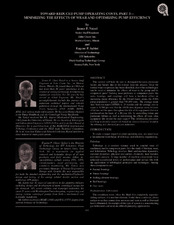| dc.contributor.other | International Pump Users Symposium (19th : 2002) | |
| dc.creator | Netzel, James P. | |
| dc.creator | Sabini, Eugene P. | |
| dc.date.accessioned | 2017-10-05T16:27:59Z | |
| dc.date.available | 2017-10-05T16:27:59Z | |
| dc.date.issued | 2002 | |
| dc.identifier.uri | https://hdl.handle.net/1969.1/164038 | |
| dc.description | Tutorial | en |
| dc.description | pg. 145 | en |
| dc.description.abstract | This tutorial will help the user to distinguish between premature failure and failure due to the normal wear-out process. Once the normal wear-out process has been identified, then what technologies can be used to minimize the effects of wear to the pump and its component parts? Solving wear problems to component parts like seals, bearings, and couplings will have a beneficial effect on increasing pump efficiency. In the United States alone, the ANSI pump population is greater than 750,000 units. The average mean time between repairs (MTBR) is 18 months and the average cost to repair is $2500 per unit. For the ANSI class of pumps alone, billions of dollars will be spent throughout the life of the equipment that was purchased on the basis of a 20-year life. In controlling infant and premature failures as well as minimizing the effects of wear, what equipment life should the user expect? The information presented will help to identify system life based on classes of service found in the refining and chemical process industries. | en |
| dc.format.medium | Electronic | en |
| dc.format.mimetype | application/pdf | |
| dc.language.iso | en | |
| dc.publisher | Texas A&M University. Turbomachinery Laboratories | |
| dc.relation.ispartof | Proceedings of the 19th International Pump Users Symposium | en |
| dc.subject.lcsh | Pumping machinery | en |
| dc.title | Toward Reduced Pump Operating Costs, Part 3 - Minimizing The Effects Of Wear And Optimizing Pump Efficiency | en |
| dc.type.genre | Presentation | en |
| dc.type.material | Text | en |
| dc.identifier.doi | https://doi.org/10.21423/R1ZT20 | |


